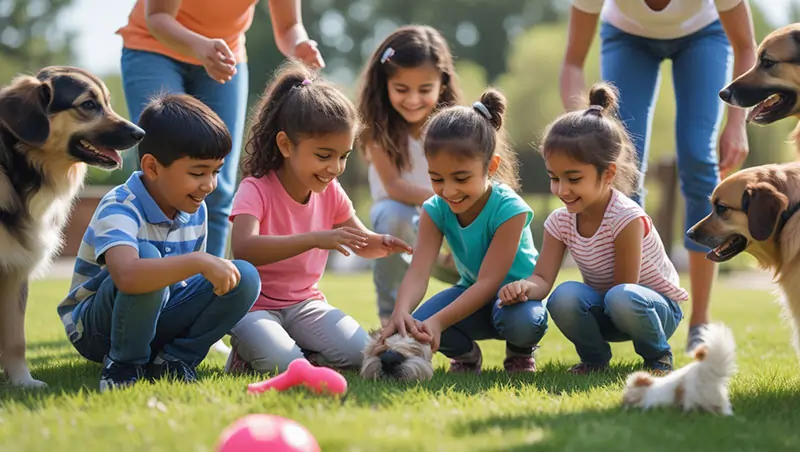12 Fun Ways to Teach Kids Dog Safety Through Play
When you introduce a dog to your family, it can be a life-changing experience. However, especially when you have children around. Dogs teach kids empathy, responsibility, and unconditional love.
It’s crucial to educate children on how to interact safely with dogs. Young children may not recognize that a dog is not a toy. And without proper guidance, their innocent actions can lead to stress for the dog. Though, they will end up biting or leaving injuries.
Teaching kids about respectful behavior around dogs can help build safe and positive interactions. Children naturally learn through play, so turning lessons into games and activities makes safety fun.
Whether you have a new puppy, a senior rescue, or are visiting friends with dogs, it’s a great opportunity to incorporate canine safety into your home in a playful way.
12 Playful Ways to Teach Kids How to Stay Safe With Dogs
Here are 12 fun and practical ways to teach kids dog safety through play, including tips for breeds with special conditions like IVDD in French bulldogs.
1. Start With Role Playing Activity with Stuffed Animals
Young children enjoy pretending. Use stuffed dogs to act out scenarios like greeting, brushing, or feeding them. You can also demonstrate what not to do, like pulling tails or approaching while a dog is eating, and having your child correct the actions.
Create a vet game where your child “examines” a stuffed dog, learning safe areas to touch (like the back and sides) and areas to avoid (like the tail, ears, and paws).
2. Doggy Edition – Red Light, Green Light
This modified classic game teaches kids when to approach dogs safely. Use signs like:
– Green light: This means the dog is calm and wagging.
– Yellow light: This means the dog is eating or sleeping.
– Red light: This means the dog is hiding, growling, or injured.
Kids call out the light color and respond accordingly, helping them learn canine body language in a fun way.
3. Build a “Safe Dog Spacecraft”
Let kids build a mini doghouse from cardboard boxes with pillows, water bowls, and signs like “Doggie Resting – Do Not Disturb.” This hands-on project teaches children about boundaries and gives dogs a break. If your real dog uses the safe zone, kids can learn to respect it just like their project.
4. Spend Some Peaceful Story Time with Dog-Safety Books
Books are a great way to introduce serious concepts gently. Choose age-appropriate dog-safety books that teach through storytelling and illustrations, then discuss the lessons afterward. Encourage kids to create their own safety story books with illustrations!
5. Freeze Tag – Understanding “Freeze” Cues
During stressful situations or when a dog is scared, the dog may “freeze” and stop in place. When someone calls the word “freeze,” everyone in the room must stop exactly where they are positioned.
This could be a good game to make fun and engaging for both dogs and their owners. This game can help improve a dog’s obedience and focus. It is a good game to strengthen a child’s understanding of subtle canine cues in addition to adding fun trivia questions between rounds to reinforce their learning.
6. Keeping Training Helpers
Kids enjoy being involved. Let them be “assistant trainers” during obedience sessions by giving commands or rewarding the dog with treats under supervision.
This boosts their confidence and teaches respectful communication with dogs. Avoid physical tricks and monitor interactions, especially with small or sensitive dogs.
7. “Dog Detective” Game – Reading Dog Body Language
Provide kids with a magnifying glass and a “clue list” of canine body language signs:
– Tail wagging = happy
– Ears back = nervous
– Licking lips = anxious
– Yawning = stressed
Then, embark on a “dog detective” walk around the house or neighborhood (with proper supervision) to identify real or pretend dog body cues. This activity is both educational and incredibly fun!
8. Let’s Entertained with Bark Bingo
To promote safe interactions with dogs, consider creating a bingo card. The card may feature various safety skill goals for children. As children accomplish these skills, they can mark them off on their cards. To enhance motivation, provide small rewards or badges for completing a line or the entire card.
9. Gentle Handling Practice with DIY Dog Toys
Creating dog toys from old T-shirts or safe, dog-friendly materials teaches children to handle items gently and understand what dogs enjoy, like playing with tug toys under structured rules. Rough games or teasing can stress or harm dogs, particularly older ones.
10. Play A New Version of Safety Simon Says
Play a version of “Simon Says” with dog safety actions:
- “Simon says to gently pet the dog.”
- “Simon says to wait until you get permission before getting close.”
- “Simon says to walk quietly past the dog.”
This fun group activity encourages listening skills while reinforcing safety rules. Use toys or imaginary dogs to avoid overwhelming real ones.
11. “Be a Tree” Practice Drill
Teach the “Be a Tree” method for handling a strange or overly excited dog. Simply:
- Stand still.
- Cross your arms.
- Look down at the ground.
- Remain silent.
Make it a speed challenge to see who can “be a tree” the quickest, using a stuffed dog or an adult pretending to be an over-friendly dog. This skill can help prevent bites or accidents during unexpected dog encounters.
12. Puppet Show for Your Pups
Encourage your kids to put on a puppet show with dog puppets or socks to demonstrate both safe and unsafe behaviors around dogs. Have their siblings or friends participate as the audience, guessing what’s appropriate. This engaging activity not only reinforces important lessons about pet safety, but also develops their creativity, storytelling skills, and confidence.
Conclusion
Teaching kids to interact safely with dogs can be joyful and rewarding. By turning safety lessons into playful activities, you help children build trust, empathy, and awareness. A child who respects a dog’s boundaries is safer and more likely to build a positive bond with their furry friend. Play smart, laugh often, and create a happier world for both kids and dogs, one game at a time.

